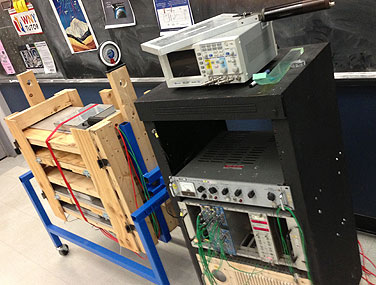Dec 14 2012
UB researchers drew a crowd of about 100 people to HiggsFest, an event held last week that celebrated the discovery of the Higgs boson, an important new subatomic particle.
 This “muon” detector, a type of particle detector, was on display at HiggsFest. Sal Rappoccio describes a muon as “an unstable, heavier version of the electron, which often is created when cosmic rays from space strike the upper atmosphere of the Earth.” Muons, he says, “pass through matter easily and one of them is striking your head every few seconds of every day of your life!”
This “muon” detector, a type of particle detector, was on display at HiggsFest. Sal Rappoccio describes a muon as “an unstable, heavier version of the electron, which often is created when cosmic rays from space strike the upper atmosphere of the Earth.” Muons, he says, “pass through matter easily and one of them is striking your head every few seconds of every day of your life!”
“Festivities” opened with a public lecture by five physicists who contributed to the search for and study of the Higgs: Professor Doreen Wackeroth; Associate Professors Ia Iashvili, Avto Kharchilava and Dejan Stojkovic; and Assistant Professor Sal Rappoccio.
One highlight was Iashvili’s presentation on the Large Hadron Collider (LHC), the world’s most powerful particle accelerator. Protons in the LHC travel at up to 99.999999 percent of the speed of light, Iashvili said.
She and Kharchilava helped plan and build the Compact Muon Solenoid detector (CMS), a particle detector within the LHC that scientists used to hunt the Higgs. The core of the device consists of several layers of special materials arranged in a cocentric fashion (as in an onion). The way that particles travel through each layer helps scientists determine what the particles are. To demonstrate how the CMS detects different particle types, Iashvili showed an interactive graphic similar to this one.
Following the HiggsFest lecture, children and other guests had the chance to take part in Higgs-related fun. Activities included a demonstration of a real-life particle detector that looks for a kind of particle called a muon, which Rappoccio describes as “an unstable, heavier version of the electron.”
The Higgs boson has been grabbing international headlines since July when scientists announced they may have caught a glimpse of the elusive particle after years of searching. The boson, which helps explain why objects have mass, is a critical piece of the Standard Model of particle physics that physicists use to describe how the world works.
For many years, the Higgs was the only Standard Model particle that researchers had not observed. That changed this summer when scientists using two LHC detectors—including the CMS—reported seeing something that looked tantalizingly like the Higgs. At a conference in Japan this November, experts presented further evidence that the particle they had glimpsed was, indeed, the long sought-after boson.